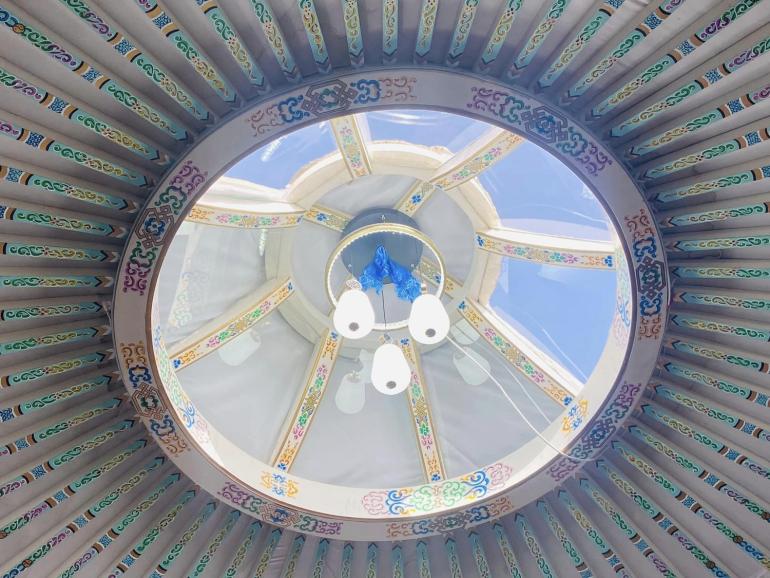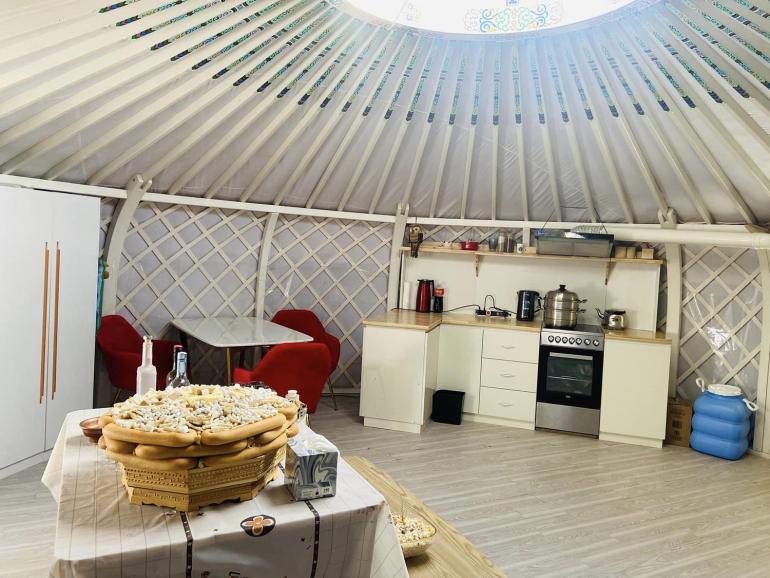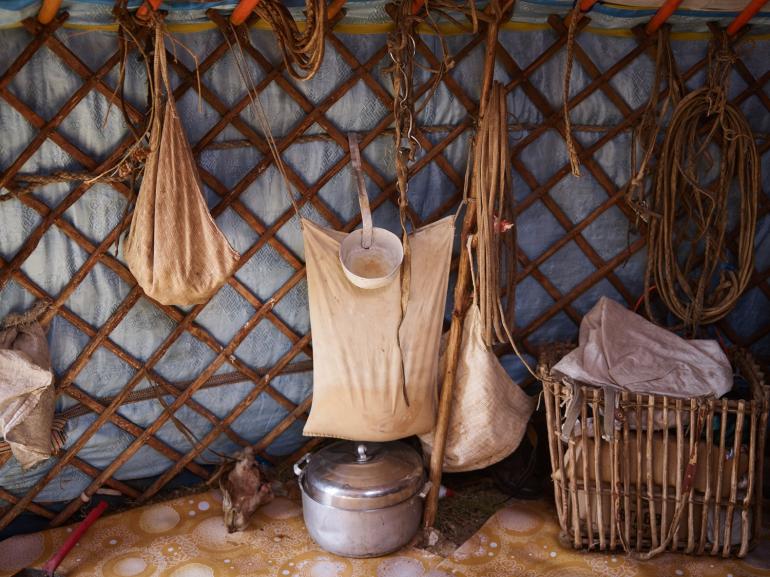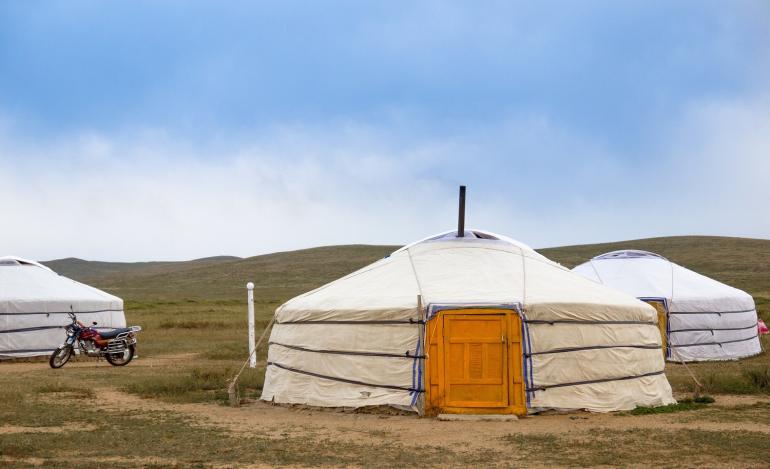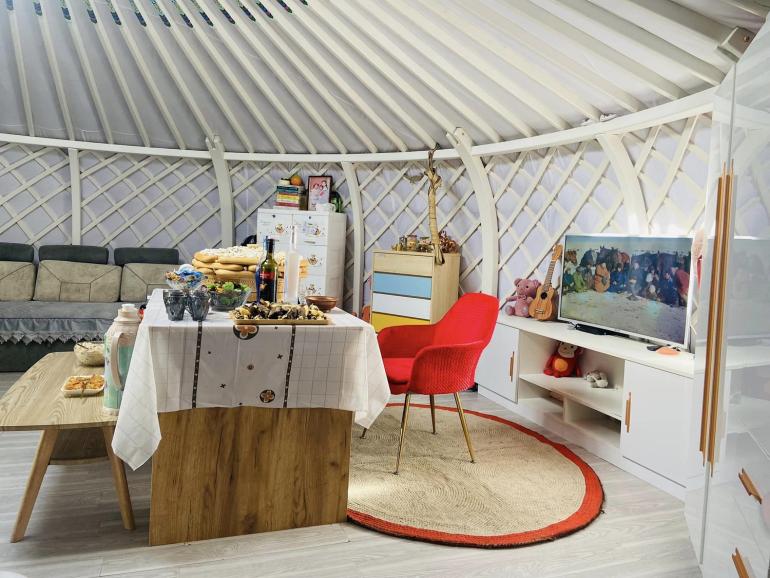Yurts
This article goes into more detail about Mongolian yurts and its history. A Mongolian yurt is a traditional type of semi-permanent housing used by the nomads of the Central Asian region and of the Middle Easian steppes. Various petroglyphs have been found that prove that Mongolian yurts were built more than 10,000 years ago. In the 13th century, there already existed various yurts.
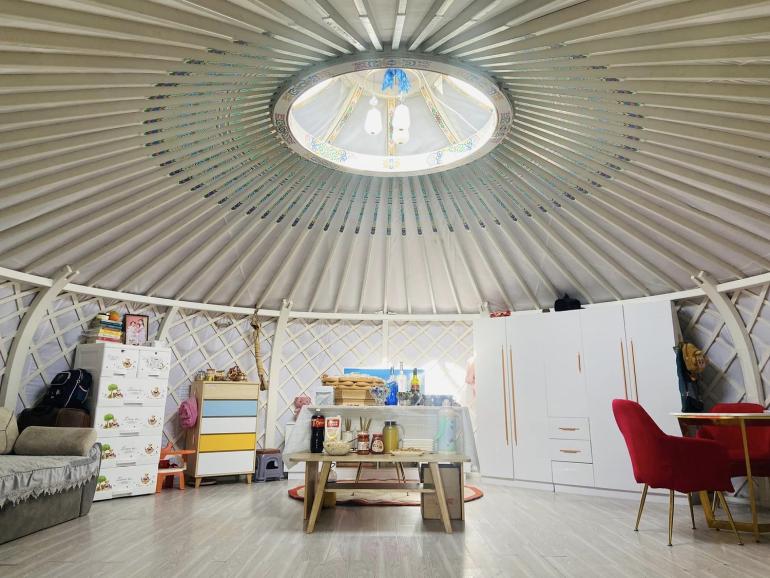
The current Mongolian yurt form has been used since the 16th century. The herders' houses had 4-5 walls, the princes' houses usually 6-8 walls and the houses of the top provincial leaders 10-12 walls.
The weight of a Mongolian yurt is 250-270 kilograms. It can therefore be transported by camels and yaks and assembled and disassembled in a few hours. Mongolian yurts are mainly made of goat or sheep skins as well as wood and leather, with the skins serving as waterproofing and insulation. The frame consists of several wooden poles arranged in a circle or an oval, forming a very strong framework. This framework is then covered with the fur to ensure a windproof and waterproof shelter. It is therefore a light and compact house suitable for moving around. Mongolian yurts are also very versatile, as they can be used as a place to sleep, a place to live or even a kitchen. It is customary among Mongolians to politely greet passing travellers and have tea with them. People often help each other build yurts, whether they know each other or not, they like to help each other. The size of a yurt is determined by the number of walls.
Because the yurt is round like the earth, bad energy does not stick to its corners, people can rest and sleep well in the yurt, while anger and frustration can also be relieved.
The felt wall can exchange air 500 times per hour. The Mongolian yurt is the most common mobile house that can be used in all four seasons. Mongolian yurts are a symbol of nomadic culture and Mongolian history. These mobiles have been built by nomads since ancient times and are designed to withstand the elements. Today, Mongolian yurts are still widely used, especially in the steppes and deserts of the Middle East and Central Asia. Their yurts are still used as accommodation for nomadic families who have to move their herds over long distances. Some tourists also prefer to stay in a yurt to experience an authentic nomadic life.
Yurts were once used by the Mongol hordes of Genghis Khan and were an essential part of the military and commercial success of the Mongols of that time.
The Mongolian yurt has the ability to stay warm
The Mongolian yurt has no sharp edges and is spherical like the universe, which is a true example of the theory that "a spherical body has the least heat loss" taught in middle school physics. The stove is in the centre of the yurt and distributes heat evenly throughout the room. Scientists have studied this and confirmed that there is no other type of enclosure that can store heat better than a yurt.
Advantages of the Mongolian yurt
- Mongolian yurts are storm and earthquake resistant. Due to their low round shape, they can withstand gusts of wind and do not collapse when properly fixed.
- Mongolian yurts do not "drift" in the rain. The retaining wall is firmly attached to the ground and can be raised to prevent flooding during storms.
- Mongolian yurts make very good use of space. Round shapes are best suited for nomadic furniture.
- There is good and natural light in Mongolian yurts. The tono fulfils the same function as a window in a modern building and is also designed for optimal air circulation.
- Mongolian yurts can be adapted according to weather conditions. In the hot summer, Mongolian yurts can be cooled by covering them with a layer of felt. In the cold winter, you can keep the Mongolian yurt warm by covering it with a double layer of felt. It provides double protection in the rain.
Mongolian yurts have a round shape, which makes it possible to fully utilise the living area. Because Mongolian yurts are low, they are wind-resistant. The felt cover keeps the warmth in, while the tono lets in wind and light. It is sunny in Mongolia for about 300 days a year. In the cold seasons of autumn, winter and spring, the abundant incoming solar heat is important for warming the yurt. Since ancient times, the Mongols have determined the time of day with the help of the sun's rays. The assembly and disassembly of a Mongolian yurt has a strict sequence.
The Mongolian yurt corresponds to the sundial
In Mongolian yurts, four walls facing the four cardinal directions go hand in hand with the sundial. Mongolians keep track of time by dividing the sunlight reflected from the number of yurts into the time of sunrise and sunset. For example, it is
- 4-6 am when the sunlight falls on a number (tiger-hair time).
- 6-10 am, when the sunlight falls from the head of the horse to the head of the wall (hare-dragon-snake time)
- 12 noon, when the sunlight falls directly into the home speaking into the yurt (horse time)
Mongolians always build their front doors facing south. When they sleep, they sleep with their heads facing north. For Mongolians, the north is the magnetic centre of the earth. A person living in a Mongolian household will not be affected by cardiovascular diseases because they are located along the earth's magnetic field.
In recent years, there has been a huge increase in the number of non-Mongolians interested in Mongolian yurts.
It is amazing to see that in some countries there are families living in both yurts and flats, including the addition of the traditional Mongolian style of living. Resorts using Mongolian yurts are also increasing and becoming a destination for travellers who want to spend the night in nature.
Wood carvers craft wooden walls, wooden floors to wooden furniture for Mongolian yurts with impressive skills and precision. Therefore, an intricately designed Mongolian yurt that incorporates traditional Mongolian patterns is a valuable asset of Mongolian history.
In 2022, about 1,000 yurts were exported from Mongolia to 13 countries, including the United States of America, Canada, Greece and France.
In Scandinavia, there is a camp for travellers who want to see the Northern Lights. This camp allows travellers to stay in a Mongolian yurt under the stars in a peaceful environment. The cost to stay in one of these Mongolian yurts is approximately $300 for one day. This holiday camp is located in Finland, and visitors come back very satisfied time and time again.
https://districtrovaniemi.com/yurt-district/
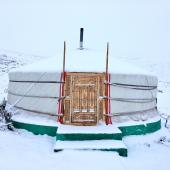

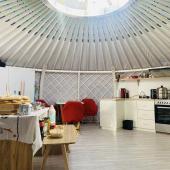
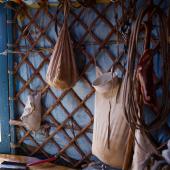
FAQs on Mongolian Yurts
Where are Mongolian yurts traditionally placed?
Mongolian yurts are traditionally set up near water sources, on pastures or near forests. They are usually erected on a flat, level surface that is protected from wind and weather.
How many sides does a Mongolian yurt have?
There is no standard number of sides that a Mongolian yurt must have. Most yurts have four sides, but there are also yurts with more or fewer sides.
What materials are used to make a Mongolian yurt?
Wood, leather, fur and rope are usually used to make a Mongolian yurt. Wood is used for the frame of the yurt, while leather and fur serve as a cover. Rope is used to hold the frames together and to fix the cover.
How long does it take to put up a Mongolian yurt?
It depends on how many people are helping to set it up and how much experience they have. A group of experienced people can set up a Mongolian yurt in about one day. A group of beginners may need several days.
What are the functions of Mongolian yurts?
Mongolian yurts serve as dwellings and are an important part of Mongolian culture. They are made of leather, skins and wood and offer protection from the harsh climatic conditions in Mongolia. They are also a symbol of the nomadic way of life of the Mongols. Several families can live in a yurt and it also offers space for guests. They are also a place where people can gather to eat, sleep and celebrate.
How many people live in a Mongolian yurt?
There is no exact figure, but it is estimated that about one million people in Mongolia live in yurts.
What is the significance of Mongolian yurts in Mongolian culture?
Mongolian yurts are an important part of Mongolian culture. They are a symbol of the nomadic way of life of the Mongols and are used as temporary dwellings. They are also a symbol of family, as they are usually inhabited by several generations of a family. Yurts are also a symbol of hospitality, as they are usually open to guests. They are also a symbol of Mongolian culture, as they are often decorated with traditional Mongolian patterns and symbols.
What colours are used for decorating Mongolian yurts?
Mongolian yurts are usually decorated in vibrant colours that relate to nature. These include red, blue, green, yellow and orange. These colours symbolise the four elements: earth, water, fire and air. Mongolian yurts are also often decorated with traditional patterns and symbols.


